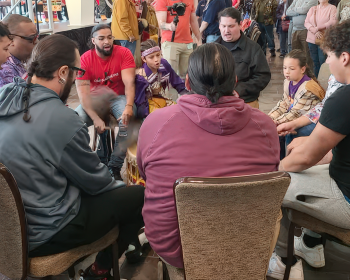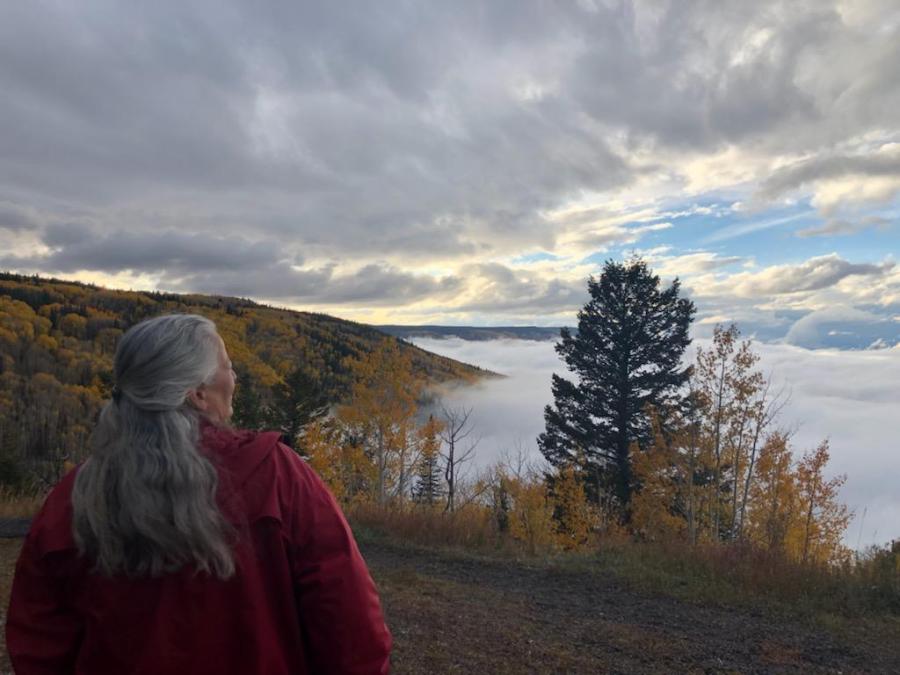
By Ariel Iannone Román
This year’s wildfire season, which started as early as mid-May in California, has been disproportionately impacting Indigenous communities in two very different ways. The first is the reality of fires burning through Tribal reservations as well as on sacred lands. The second is the reality of Indigenous migrant farm workers, who are already a vulnerable population without much option but to keep working despite the pandemic, and now, are exposed to the toxic air quality caused by wildfire smoke. A high percentage of the farm workers working in Washington, Oregon, and California are undocumented migrant workers, and many come from Indigenous communities.
In Washington, the five fires that started in early September heavily impacted the Colville Reservation, resulting in the loss of over 80 homes, the destruction of over 200,000 acres of land, and one death. In California, the Slater fire has burned down the homes of Karuk Tribal members and Tribal staff and the Red Salmon complex fire is burning an area that is sacred to the Karuk Peoples. Also in California, farm workers haven't been guaranteed the most basic of protections against COVID-19 and the smoke from wildfires. Even though state and agricultural groups have reportedly distributed millions of N-95 masks to employers, farmworker rights protection groups have reported that hardly any workers have actually received the masks. Because of the fact that many of the workers are undocumented, they are afraid to report violations, and similarly, are unable to choose not to work despite the toxic air quality. According to the U.S. Environmental Protection Agency, an air quality index (AQI) that exceeds 150 is unhealthy for the general population, and in California, the AQI has far exceeded this amount in many areas.
In Oregon, the organization Pineros y Campesinos Unidos del Noroeste (PCUN) reported that farm workers were being asked to work despite Level 2 evacuation warnings and hazardous air quality. According to PCUN, Oregon Occupational Safety and Health (Oregon OSHA) and the Oregon Health Authority (OHA) recommended a halt to outdoor work activity when air quality exceeds 151 AQI, as well as rearranging schedules so that workers could get relief from smoke exposure, and providing N-95 masks where and when applicable. In mid-September, air quality has far exceeded this amount, though workers were still being asked to report for work.
As of September 21, 2020, over 40,000 fires have burned close to 7 million acres of land. This exceeds the 10-year average by one million acres. What we are seeing are the consequences of decades of fire suppression, the federal government’s preferred tactic for dealing with wildfires, which ignores generations of traditional Indigenous knowledge regarding fire management.
At one time, before the advent of colonization and the forced displacement of Indigenous Peoples, the risk of fire was managed via what is now called cultural burning. Cultural burning practices encompass different techniques of controlled burning that have been passed down by Indigenous Peoples living in areas with high risk of wildfires. The key to cultural burning is that the practice reflects an intimate understanding of the landscape, as opposed to federal and state tactics, which seek to suppress all fire without acknowledging its potential benefits. In California and Oregon, religious ceremonies related to cultural burning were banned by the mid-1800s, with Tribal members being shot by law enforcement over fire disputes as recently as the 1930s.
In more recent times, Indigenous leaders in California and Oregon have begun to push for government-sanctioned land management practices to include aspects of cultural burning. A similar movement is happening in Australia, after the devastation of the wildfires that burned over 11 million acres of land in Western Australia over the course of August 2019 through March 2020. In the Northwest Territories, cultural burning practices have remained largely intact as part of Aboriginal fire and land management practices, resulting in a 50 percent decrease in bushfire destruction. According to Oliver Costello (Bundjalung Jagun), CEO of the Firesticks Alliance, “Greater devastating fires are the future for Australia if we continue to apply short term thinking to what is a long-term problem, [one] that has been 200 years in the making.” This sentiment could apply to California, Oregon, and Washington as well, where the ban of cultural burning practices over the last 200 years has resulted in the accumulation of small trees, grass, brush, leaves, and other forest debris that provide the fuel needed for a wildfire to grow into a severe burn. Climate change and rising temperatures make these landscapes every more fire-prone than they already were.
In Northern California, fire experts from the North Fork Mono, Karuk, and Yurok Peoples have begun to partner with the Forest Service to integrate traditional practices, including cultural burning, into governmental land management plans. The state of California has committed to reducing undergrowth on half-a-million acres, and the federal government has a similar goal. Unfortunately, this is not an easy problem to fix, as fire cannot be easily added back into an ecological system that has been impacted by decades of fire suppression. Another problem is the general lack of governmental consensus. President Trump blamed the severity of the wildfires solely on poor forest management and suggested that the solution be an increase in logging, ignoring the impact of climate change, as well as the benefits of restoring traditional Indigenous forest management practices. Within the state of California, changes in forest management policy have also been made difficult due to regional air regulators who still require burn permits due to concerns over smoke and air pollution. Only certain counties offer special burn permits for Tribes to engage in cultural burning practices.
The Karuk Tribe, whose lands span northwestern California and southern Oregon, put together the Somes Bar Integrated Fire Management Project, which combines strategic forest thinning with controlled burns in a groundbreaking piece of policy that incorporates the most Indigenous knowledge into traditional policy in the United States to date. The project has stalled in the early stages due to continued resistance from federal officials to allow Tribal members to engage in controlled burns, as well as the recurrence of devastating fire seasons, which by necessity push officials back into using fire suppression tactics to deal with the problem in the short-term.
The result is a job left dangerously half-done. Karuk fire management professionals completed the first part of the project, which entailed strategic forest thinning. The resulting collection of slash piles, composed of debris and branches, were never burned as was originally intended. Federal officials were too busy dealing with the catastrophic wildfire season to arrange for their own people to do the controlled burns, and they did not want to turn the responsibility over to the Karuk Tribe, citing liability issues, despite the fact that the Tribe has members who are certified in controlled burn management. What is left is a collection of fuel piles that could make an already catastrophic fire season worse. Bill Tripp (Karuk), the director of natural resources and environmental policy for the Karuk Tribe Department of Natural Resources, wrote in an article for The Guardian that the federal government keeps giving “excuses, not solutions.” Excuses have ranged from lack of environmental clearance under the National Environmental Policy Act, the previously mentioned liability concerns, lack of personnel to supervise the burn, and the latest — COVID-19.
The problem is not simply one of crisis management, but also one of Indigenous rights, Tribal sovereignty, and cultural preservation. According to Tripp, “Overcoming the structural racism at the root of this problem has been a multi-generational task. It shouldn’t have to be.” The multi-generational task doesn’t just involve the fight to be included in governmental land management policy, but also the need to ensure that the traditional knowledge held by the elders of different Indigenous Peoples is being passed on before it is lost.
Photo by Tony Salas.



